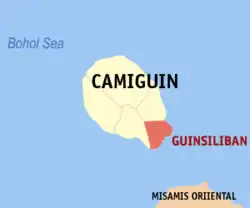Guinsiliban | |
|---|---|
| Municipality of Guinsiliban | |
 Guinsiliban Port | |
 Flag | |
 Map of Camiguin with Guinsiliban highlighted | |
OpenStreetMap | |
.svg.png.webp) Guinsiliban Location within the Philippines | |
| Coordinates: 9°06′N 124°47′E / 9.1°N 124.78°E | |
| Country | Philippines |
| Region | Northern Mindanao |
| Province | Camiguin |
| District | Lone district |
| Founded | June 13, 1950 |
| Barangays | 7 (see Barangays) |
| Government | |
| • Type | Sangguniang Bayan |
| • Mayor | Helenio N. Abecia (PDPLBN) |
| • Vice Mayor | Elvis O. Roxas (PDPLBN) |
| • Representative | Jurdin Jesus M. Romualdo |
| • Municipal Council | Members |
| • Electorate | 5,395 voters (2022) |
| Area | |
| • Total | 18.52 km2 (7.15 sq mi) |
| Elevation | 82 m (269 ft) |
| Highest elevation | 676 m (2,218 ft) |
| Lowest elevation | 0 m (0 ft) |
| Population (2020 census)[3] | |
| • Total | 6,685 |
| • Density | 360/km2 (930/sq mi) |
| • Households | 1,707 |
| Economy | |
| • Income class | 6th municipal income class |
| • Poverty incidence | 30.36 |
| • Revenue | ₱ 54.72 million (2020) |
| • Assets | ₱ 99.3 million (2020) |
| • Expenditure | ₱ 48.37 million (2020) |
| • Liabilities | ₱ 25.71 million (2020) |
| Service provider | |
| • Electricity | Camiguin Electric Cooperative (CAMELCO) |
| Time zone | UTC+8 (PST) |
| ZIP code | 9102 |
| PSGC | |
| IDD : area code | +63 (0)88 |
| Native languages | Kinamigin Cebuano Tagalog |
| Website | www |
Guinsiliban, officially the Municipality of Guinsiliban, is a 6th class municipality in the province of Camiguin, Philippines. According to the 2020 census, it has a population of 6,685 people.[3]
Geography
Barangays
Guinsiliban is politically subdivided into 7 barangays. Each barangay consists of puroks while some have sitios.
- Butay
- Cabuan
- Cantaan
- Liong
- Maac
- North Poblacion
- South Poblacion
Climate
| Climate data for Guinsiliban, Camiguin | |||||||||||||
|---|---|---|---|---|---|---|---|---|---|---|---|---|---|
| Month | Jan | Feb | Mar | Apr | May | Jun | Jul | Aug | Sep | Oct | Nov | Dec | Year |
| Average high °C (°F) | 28 (82) |
28 (82) |
29 (84) |
30 (86) |
30 (86) |
29 (84) |
29 (84) |
30 (86) |
30 (86) |
29 (84) |
29 (84) |
28 (82) |
29 (84) |
| Average low °C (°F) | 23 (73) |
23 (73) |
23 (73) |
23 (73) |
24 (75) |
25 (77) |
25 (77) |
25 (77) |
25 (77) |
25 (77) |
24 (75) |
24 (75) |
24 (75) |
| Average precipitation mm (inches) | 327 (12.9) |
254 (10.0) |
185 (7.3) |
128 (5.0) |
215 (8.5) |
273 (10.7) |
248 (9.8) |
243 (9.6) |
214 (8.4) |
246 (9.7) |
271 (10.7) |
271 (10.7) |
2,875 (113.3) |
| Average rainy days | 24.3 | 21.1 | 22.5 | 20.6 | 28.3 | 28.8 | 29.4 | 29.0 | 28.0 | 28.3 | 26.0 | 24.2 | 310.5 |
| Source: Meteoblue[5] | |||||||||||||
Demographics
| Year | Pop. | ±% p.a. |
|---|---|---|
| 1960 | 3,499 | — |
| 1970 | 5,686 | +4.97% |
| 1975 | 4,057 | −6.55% |
| 1980 | 4,254 | +0.95% |
| 1990 | 4,341 | +0.20% |
| 1995 | 4,919 | +2.37% |
| 2000 | 5,092 | +0.74% |
| 2007 | 5,559 | +1.22% |
| 2010 | 5,580 | +0.14% |
| 2015 | 6,281 | +2.28% |
| 2020 | 6,685 | +1.23% |
| Source: Philippine Statistics Authority[6][7][8][9] | ||
In the 2020 census, the population of Guinsiliban was 6,685 people,[3] with a density of 360 inhabitants per square kilometre or 930 inhabitants per square mile.
References
- ↑ Municipality of Guinsiliban | (DILG)
- ↑ "2015 Census of Population, Report No. 3 – Population, Land Area, and Population Density" (PDF). Philippine Statistics Authority. Quezon City, Philippines. August 2016. ISSN 0117-1453. Archived (PDF) from the original on May 25, 2021. Retrieved July 16, 2021.
- 1 2 3 Census of Population (2020). "Region X (Northern Mindanao)". Total Population by Province, City, Municipality and Barangay. Philippine Statistics Authority. Retrieved 8 July 2021.
{{cite encyclopedia}}: CS1 maint: numeric names: authors list (link) - ↑ "PSA Releases the 2018 Municipal and City Level Poverty Estimates". Philippine Statistics Authority. 15 December 2021. Retrieved 22 January 2022.
- ↑ "Guinsiliban: Average Temperatures and Rainfall". Meteoblue. Retrieved 4 March 2020.
- ↑ Census of Population (2015). "Region X (Northern Mindanao)". Total Population by Province, City, Municipality and Barangay. Philippine Statistics Authority. Retrieved 20 June 2016.
{{cite encyclopedia}}: CS1 maint: numeric names: authors list (link) - ↑ Census of Population and Housing (2010). "Region X (Northern Mindanao)" (PDF). Total Population by Province, City, Municipality and Barangay. National Statistics Office. Retrieved 29 June 2016.
{{cite encyclopedia}}: CS1 maint: numeric names: authors list (link) - ↑ Censuses of Population (1903–2007). "Region X (Northern Mindanao)". Table 1. Population Enumerated in Various Censuses by Province/Highly Urbanized City: 1903 to 2007. National Statistics Office.
{{cite encyclopedia}}: CS1 maint: numeric names: authors list (link) - ↑ "Province of Camiguin". Municipality Population Data. Local Water Utilities Administration Research Division. Retrieved 17 December 2016.
External links
This article is issued from Wikipedia. The text is licensed under Creative Commons - Attribution - Sharealike. Additional terms may apply for the media files.